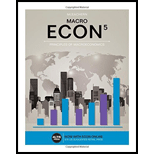Question 2 - Consider an economy that produces bread and cars. In the table 2.1 below are data for the different years: Table 2.1 Year 2008 Year 2018 Price of a loaf of bread $10 $20 Number of loaves of bread 500,000 400,000 Price of a car $50,000 $60,000 Number of cars produced 100 120 Using the year 2008 as the base year, compute the following for each year: i. Nominal GDP ii. Real GDP iii. How much have prices risen between year 2008 and 2018? b. Consider the scenario. The country Global-Land is really small and only has 500 In 2023 in total, they spend ECD 200,000 per year on food, ECD 200,000 on clothing, and ECD 100,000 on public and private transport. The economy of Global-Land has three industries: Juice, Clothing and Furniture. The output of each industry is disposed either on the domestic market or exported. The institutional sectors of the economy are the Household, Government, Corporate and Rest of the World, which either purchase the products of the industries or provide the factor services. The Juice and Clothing industries just bought ECD 2,000,000 worth of new machinery. Meanwhile, the Furniture is the largest industry. This industry has increased its inventory by ECD 200,000 as compared to the previous year. In addition to that, a Global-Land resident buys a new house worth ECD 300,000. Of course, the government of Global-Land knows how important education is. Therefore, it spends ECD 1,000,000 a year to run a public school and pay all the teachers who work there. In addition to that, the government contributes ECD 500,000 to fix broken roads and highways throughout the year. In addition, Global-Land total domestically produced goods and services is worth ECD 1,500,000 this year. In the meantime, the country also purchase foreign goods and services is worth ECD 1,000,000. i. Using the information provided in the scenario, calculate GDP using the expenditure approach. Please show all components of each measure. ii. Further information on the activities of the Juice industry in 2023 is provided in table 2.1 below in millions of Eastern Caribbean dollars (ECD). Table 2.1 ECD million Subsidies 0 Gross national product at market prices 300 Imports 30 Net national product 275 Exports 30 Net national product at factor cost 260 Personal savings 15 Personal income 225 Government transfer payments 5 Undistributed corporate profits 20 Government expenditure on commodities 40 Personal consumption 160 Using the following Global-Land 2022 data in table 2.1 provide Estimates of the Following Key National Accounting Aggregates: a. Personal disposable income b. Indirect taxes c. Net investment d. Depreciation e. Corporate income taxes f. Personal income taxes
Question 2 -
- Consider an economy that produces bread and cars. In the table 2.1 below are data for the different years:
|
Table 2.1 |
|
|
|
|
Year 2008 |
Year 2018 |
|
|
$10 |
$20 |
|
Number of loaves of bread |
500,000 |
400,000 |
|
Price of a car |
$50,000 |
$60,000 |
|
Number of cars produced |
100 |
120 |
|
|
Using the year 2008 as the base year, compute the following for each year: |
|
|
i. |
Nominal |
|
|
ii. |
Real GDP |
|
|
iii. |
How much have prices risen between year 2008 and 2018? |
|
b. Consider the scenario. The country Global-Land is really small and only has 500 In 2023 in total, they spend ECD 200,000 per year on food, ECD 200,000 on clothing, and ECD 100,000 on public and private transport. The economy of Global-Land has three industries: Juice, Clothing and Furniture. The output of each industry is disposed either on the domestic market or exported. The institutional sectors of the economy are the Household, Government, Corporate and Rest of the World, which either purchase the products of the industries or provide the factor services. The Juice and Clothing industries just bought ECD 2,000,000 worth of new machinery. Meanwhile, the Furniture is the largest industry. This industry has increased its inventory by ECD 200,000 as compared to the previous year. In addition to that, a Global-Land resident buys a new house worth ECD 300,000. Of course, the government of Global-Land knows how important education is. Therefore, it spends ECD 1,000,000 a year to run a public school and pay all the teachers who work there. In addition to that, the government contributes ECD 500,000 to fix broken roads and highways throughout the year. In addition, Global-Land total domestically produced goods and services is worth ECD 1,500,000 this year. In the meantime, the country also purchase foreign goods and services is worth ECD 1,000,000.
i. Using the information provided in the scenario, calculate GDP using the expenditure approach. Please show all components of each measure.
ii. Further information on the activities of the Juice industry in 2023 is provided in table 2.1 below in millions of Eastern Caribbean dollars (ECD).
Table 2.1
|
|
ECD million |
|
Subsidies |
0 |
|
Gross national product at market prices |
300 |
|
Imports |
30 |
|
Net national product |
275 |
|
Exports |
30 |
|
Net national product at factor cost |
260 |
|
Personal savings |
15 |
|
Personal income |
225 |
|
Government transfer payments |
5 |
|
Undistributed corporate profits |
20 |
|
Government expenditure on commodities |
40 |
|
Personal consumption |
160 |
Using the following Global-Land 2022 data in table 2.1 provide Estimates of the Following Key
National Accounting Aggregates:
a. Personal disposable income
b. Indirect taxes
c. Net investment
d.
e. Corporate income taxes
f. Personal income taxes
Step by step
Solved in 2 steps









